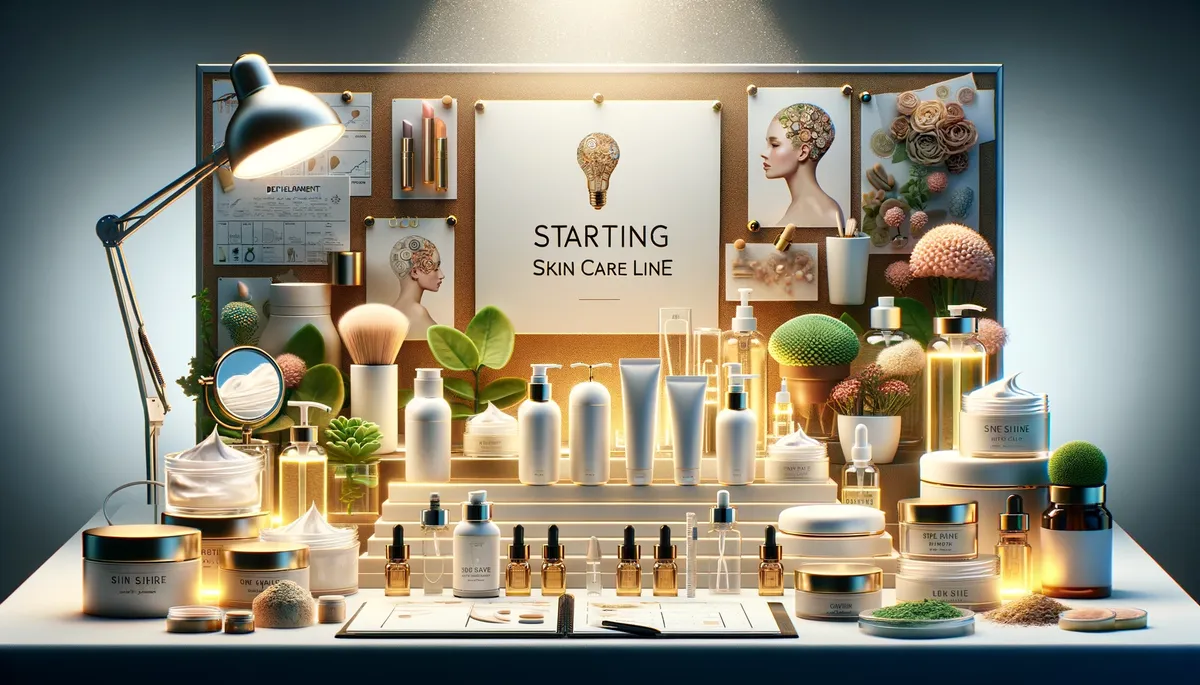How To Start a Skin Care Line – Launching a skin care brand necessitates creativity and strategy to stand out in a crowded, fast-changing beauty marketplace.
As entrepreneurs look to 2025, this 11-step guide supports developing competitive brands that meet emerging consumer needs.
Key Takeaways
Hide- Pinpoint a unique segment within the skincare market and recognize underserved areas or emerging trends.
- Analyze competitors' strategies for market positioning and stay updated on emergent trends through data analytics.
- Identify target demographics and analyze variables such as age, gender, income levels, and locations to inform product development and branding.
- Meticulously select ingredients aligned with your brand's ethos, conduct rigorous product testing for performance and safety, and ensure compliance with industry regulations and safety standards.
It examines critical foundations – from identifying underserved niches to formulating efficacious products and mastering digital-first marketing.
While bringing a vision to life requires significant research, planning and dedication, beauty founders can leverage this process to resonate with target demographics.
With user understanding and product problem-solving at the core, new entrants can realistically evolve into enduring brands.
By combining innovation with execution, future skin care labels can rise above fleeting trends to satisfy the skincare needs of tomorrow.
11 Steps To Start a Skin Care Line in 2025

Launching a skin care line poses meaningful challenges – from chemistry knowledge to production compliance to financing inventory.
However, with resourcefulness and dedication, entrepreneurs can build sustainable beauty brands without extensive capital.
Some successful online skincare business owners’ experience highlights how passion and perseverance enable bootstrapping founders to enter the market and progressively scale.
By covering areas from ingredient sourcing to regulatory steps, her advice provides pragmatism for recent entrants lacking funding.
While obstacles exist across the complex beauty industry, strategic planning helps fledgling brands control costs yet meet standards – an empowering message for all aspiring founders pursuing their vision one step at a time.
1. Identify Your Niche

Identifying your brand’s niche is a crucial step in differentiating your skincare line in the competitive beauty market.
This involves a meticulous process of pinpointing a unique segment within the broad spectrum of skincare consumers, to which your products will specifically cater.
It necessitates innovative thinking to recognize underserved areas or emerging trends that align with your brand vision. Technical analysis of consumer behavior, skincare needs, and preference patterns is indispensable.
Your niche could be defined by targeting a specific skin concern, such as hyperpigmentation or sensitive skin, or it could focus on a particular demographic, ethical stance, or ingredient philosophy.
Once the niche is determined, it becomes the foundational element around which product development, marketing strategy, and brand storytelling revolve.
It enables your brand to offer specialized solutions with a clear value proposition, which is paramount for capturing the attention of both retailers and consumers who are continuously inundated with generic options.
Your niche should be narrow enough to establish a strong identity yet flexible enough to allow for future innovation and expansion within the market.
With a well-defined niche in place, the subsequent phase involves rigorous market research to validate demand and refine your product offerings accordingly.
2. Research the Market

Thorough market research is the cornerstone of a successful skin care line. It begins with pinpointing specific demographics to tailor products effectively.
A meticulous analysis of competitors’ strategies is also crucial. This offers insights into market positioning and can highlight gaps in the current offerings.
Additionally, staying abreast of emergent trends through data analytics and consumer behavior studies is essential. This ensures the relevance and innovation of your product line in a dynamic industry.
Identify Target Demographics
Understanding your potential customer base through detailed market research is a critical step in developing a successful skin care line.
Identifying target demographics involves analyzing variables such as age, gender, income levels, and geographic locations, as well as psychographic factors like lifestyles, values, and attitudes.
This data informs product development, branding, and marketing strategies, ensuring they resonate with the intended audience.
Key demographic insights include:
- Age Range: Identifying the age bracket most likely to purchase your products can inform ingredient selection and marketing channels.
- Skin Concerns: Understanding prevalent skin issues within target demographics guides formulation and product differentiation.
- Purchasing Power: Assessing the disposable income of potential consumers helps in pricing your skin care offerings competitively.
Focusing on these aspects ensures that your skin care line meets the specific needs and preferences of your market niche.
Analyze Competitors’ Strategies
Market analysis is an indispensable step in recognizing the competitive landscape and positioning your skin care line effectively within the industry.
By meticulously dissecting the strategies of existing market leaders and niche players, you glean insights into product innovation, marketing tactics, and consumer engagement methodologies.
Deploy advanced analytics to parse through data on product assortments, pricing models, and distribution channels. Scrutinize digital footprints to understand online marketing strategies, SEO approaches, and social media prowess.
Incorporate a SWOT (Strengths, Weaknesses, Opportunities, Threats) framework to distill competitive intelligence into actionable strategies.
This technical audit should guide your product development cycle, ensuring the incorporation of cutting-edge ingredients and technologies.
Benchmark against competitors to set aspirational yet attainable goals, carving a distinctive niche in the dynamic skin care market.
Spot Emerging Trends
In the rapidly evolving beauty industry, identifying and capitalizing on emerging trends is crucial for the development of a successful skin care line.
Entrepreneurs must harness cutting-edge analytical tools and data-driven insights to forecast market shifts with precision.
This strategic foresight enables the infusion of innovation into product development, ensuring alignment with consumer expectations and market demand.
To effectively spot emerging trends:
- Leverage big data analytics to discern patterns and preferences within consumer behavior.
- Engage with social listening platforms to monitor real-time discussions and sentiment analysis.
- Collaborate with industry experts to gain foresight into technological advancements and ingredient innovations.
Embracing these methodologies positions your brand at the vanguard of skin care, delivering solutions that resonate with tomorrow’s consumer.
3. Develop Your Brand Identity
Brand identity formation is a crucial step in distinguishing your skin care line in a competitive industry, encapsulating your core values, visual aesthetic, and the unique selling proposition of your products.
In the creation of a compelling brand identity, meticulous attention to detail is paramount.
From the selection of a color palette that resonates with your target demographic to the precise typography that conveys your brand’s voice, every element must be strategically aligned and technically refined.
To evoke the desired emotional connection with your audience, consider the following table, which pairs key elements of brand identity with the emotions they typically elicit:
| Brand Identity Element | Emotion Elicited |
|---|---|
| Color Palette | Trust, Serenity |
| Logo Design | Innovation, Quality |
| Packaging | Luxury, Comfort |
| Typography | Professionalism, Clarity |
| Tagline | Inspiration, Aspiration |
Leverage cutting-edge design technology to engineer an aesthetic that is both visually arresting and indicative of your brand’s pioneering ethos.
The integration of these elements into your brand’s identity must not only be aesthetically innovative but also technically sound, ensuring consistency across all platforms and touchpoints.
This systematic approach will foster a strong, emotional brand resonance that is quintessential for market differentiation and customer loyalty.
4. Formulate Your Products
The formulation stage is critical, requiring a meticulous selection of ingredients that not only align with your brand’s ethos but also ensure efficacy and user satisfaction.
Rigorous product testing must be conducted to assess performance, stability, and safety, thereby fostering consumer trust and brand credibility.
Compliance with industry regulations and safety standards is non-negotiable, necessitating a thorough understanding of legal requirements to mitigate risk and ensure market readiness.
Ingredient Selection
Selecting ingredients meticulously is crucial for formulating effective and appealing skin care products that align with your brand’s vision and customer expectations.
The process involves a strategic blend of scientific acumen and market awareness, ensuring that each component contributes to an innovative and efficacious product.
When considering ingredients, prioritize the following:
- Bioactivity: Opt for ingredients with proven skin benefits, supported by peer-reviewed research.
- Sustainability: Source eco-friendly and ethically produced ingredients to appeal to environmentally conscious consumers.
- Synergy: Combine ingredients that work harmoniously to enhance product performance and stability.
Utilizing cutting-edge compounds and technologies can distinguish your offerings in a competitive market. Precision in formulation is non-negotiable, as it ensures safety, consistency, and consumer satisfaction.
Product Testing
Upon finalizing your skin care formula, rigorous product testing is an essential step to verify safety, efficacy, and consumer appeal.
This phase requires a multifaceted approach, integrating cutting-edge analytical techniques and user experience trials to ensure the product not only adheres to stringent industry standards but also resonates with the target market.
In-vitro assays and dermatological evaluations offer quantitative data on the product’s performance and potential for irritation or sensitization. Stability testing under variable conditions assesses shelf-life and packaging integrity.
Furthermore, consumer trials, when designed with a focus on demographically diverse panels, provide nuanced insights into the user’s sensory experience and perceived benefits.
Each test must be meticulously documented, forming a robust foundation for product claims and regulatory compliance.
Compliance & Safety
Adhering to regulatory standards and ensuring product safety are paramount when formulating your skin care line. As you innovate, integrate advanced dermatological research to identify safe and effective ingredients.
Employ precision when balancing pH levels and concentrations, ensuring each product is both skin-friendly and efficacious.
To underscore the technical aspects of compliance and safety:
- Source raw materials that are both sustainable and compliant with international safety protocols.
- Utilize state-of-the-art preservation systems to extend shelf life without compromising biocompatibility.
- Implement rigorous quality control measures, including stability and compatibility testing, to guarantee consistent product performance.
These steps embody a commitment to excellence and innovation in skin care formulation.
Next, we’ll transition into the essential considerations to ensure legal compliance within the industry’s regulatory framework.
5. Ensure Legal Compliance
Consistently ensuring legal compliance is a critical step when establishing your skincare line. This includes adhering to regulations set forth by entities such as the FDA, FTC, and local authorities.
Navigating the intricate legal frameworks requires a meticulous approach, integrating regulatory compliance from the inception of product formulation to the final packaging and marketing strategies.
Innovation in skincare often involves novel ingredients and technologies. It is paramount to seek pre-market approval or registration where necessary.
This ensures that all components and claims associated with your product are substantiated, legally recognized, and safe for consumer use.
This includes rigorous verification of raw material sources, compliance with Good Manufacturing Practices (GMP), and ensuring that labels meet the FDA’s labeling regulations under the Federal Food, Drug, and Cosmetic Act (FD&C Act).
Furthermore, aligning with the Federal Trade Commission (FTC) guidelines, your advertising must be truthful and non-deceptive, with evidence to back up claims. This adherence protects consumers and fortifies the credibility of your brand.
To maintain compliance, continuous monitoring of regulatory updates and proactive legal audits are indispensable.
Leveraging legal counsel specialized in cosmetics and skincare is recommended to navigate the complex regulatory environment, mitigating risks and fostering a foundation for a reputable and sustainable brand.
6. Source Quality Ingredients
Selecting high-quality ingredients is essential for the efficacy and safety of your skincare products. In the rapidly evolving skincare market, innovative and sustainably sourced ingredients can differentiate your brand.
To ensure the technical superiority of your products, consider the following aspects when sourcing ingredients:
- Biocompatibility: Choose ingredients that are compatible with a range of skin types to minimize adverse reactions and enhance product appeal.
- Potency and Purity: Opt for ingredients with high levels of active compounds and ensure they are free from contaminants and adulterants.
- Sourcing Transparency: Partner with suppliers who provide clear traceability of their ingredients, ensuring ethical sourcing and quality assurance.
By focusing on these technical parameters, you can formulate products that are not only cutting-edge but also maintain the highest standards of quality and performance.
It’s essential to collaborate with suppliers who are committed to innovation in extraction methods and stabilization techniques, which can significantly elevate the performance of your skincare line.
With the foundation of exceptional ingredients established, the next logical step is to encapsulate these high-caliber components in choose reliable packaging that preserves their integrity and aligns with your brand’s ethos.
7. Choose Reliable Packaging
In the development of a skincare line, selecting appropriate packaging is crucial for the protection and preservation of your product’s integrity, as well as for conveying your brand’s image to consumers.
Packaging choices should align with the innovative ethos of your brand while ensuring technical efficiency in product dispensation, stability against environmental factors, and compliance with sustainability standards.
Here is a table summarizing key packaging considerations:
| Consideration | Details |
|---|---|
| Material Innovation | Seek advanced materials that offer enhanced barrier properties, are recyclable or biodegradable, and maintain product formulation stability. |
| Dispensing Mechanism | Choose mechanisms that deliver precise quantities, minimize product oxidation, and elevate user experience through ease of use. |
| Brand Alignment | Design packaging that reflects your brand’s aesthetic, communicates your values, and stands out on the shelf. |
Invest in packaging that is both functional and aesthetically pleasing, using high-grade materials that speak to a commitment to quality and environmental responsibility.
Opt for smart designs that protect the product from contamination and degradation, thereby extending shelf life.
The technical design of your packaging should also consider ease of manufacturing and filling, as well as cost-effectiveness for scaling production.
Remember, innovative packaging can be a powerful marketing tool that differentiates your skincare line in a crowded marketplace.
8. Set Up Production
After finalizing your product’s packaging design, the next critical phase involves establishing a production line that is both cost-efficient and capable of meeting your skincare brand’s quality standards.
This step is intricate and requires a detailed strategy to ensure the end product adheres to industry regulations and consumer expectations.
To set up a production process that embodies efficiency and innovation, consider these critical components:
- Scalable Manufacturing Solutions: Invest in machinery that not only meets your current demands but also has the capability for expansion as your business grows. Modular systems that allow for easy upgrades can be a prudent choice.
- Quality Control Systems: Implement cutting-edge sensors and software that continuously monitor the production parameters. Real-time analytics can significantly improve batch consistency and reduce waste by promptly detecting deviations.
- Automation and Robotics: Explore the integration of robotic automation into your production line to enhance precision in tasks such as filling, capping, and labeling. This not only elevates product quality but also optimizes the manufacturing timeline.
Incorporating these elements into your production line will not only streamline the manufacturing process but will also provide a foundation for innovation, ensuring your skincare line remains competitive in a rapidly evolving market.
9. Plan Your Marketing Strategy
With a robust production line in place, your next move is to devise a comprehensive marketing strategy that will introduce your skincare brand to the market and build customer loyalty.
Your strategy should encompass a multi-channel approach, leveraging both digital and traditional platforms to reach your target demographic with precision.
Begin by mapping out your brand’s digital footprint. Construct an SEO-optimized website with an engaging UX design that harmonizes with your brand’s aesthetic and ethos.
Utilize data analytics to refine user experience and tailor content to visitor preferences.
Develop a content marketing plan that positions your brand as an authority in skincare, using blog posts, whitepapers, and tutorials that provide value to your audience.
In parallel, initiate a social media campaign that employs cutting-edge algorithms to target potential customers with high accuracy.
Employ visually-rich platforms like Instagram and Pinterest to showcase your products through high-definition imagery and video content.
Influencer partnerships can amplify your reach, but choose collaborators whose audiences align closely with your ideal customer profile.
Supplement digital efforts with experiential marketing—host pop-up shops or attend trade shows where potential customers can physically interact with your product line. Implement a CRM system to capture customer data and personalize future marketing efforts, ensuring repeat engagement and fostering brand loyalty.
10. Launch Your Online Presence
Establishing a robust online presence is a pivotal step in launching a skin care line. The confluence of aesthetics and functionality in website design becomes a silent ambassador for your brand.
A strategic approach to social media leverages algorithmic trends and audience engagement. This helps to elevate brand visibility and foster community growth.
Meanwhile, optimizing your digital content for search engines is essential. By utilizing keywords specific to skincare, you can ensure that your brand ranks prominently. This enhances organic reach and customer acquisition.
Website Design Essentials
In terms of establishing an online presence for your skin care line, a well-designed website serves as the cornerstone of your digital marketing efforts.
A meticulously structured interface enhances user experience, while backend optimization ensures agility and responsiveness. To captivate a forward-thinking audience, focus on the following essentials:
- Intuitive Navigation: Streamlined pathways that facilitate effortless exploration of your product portfolio.
- Responsive Design: A layout that seamlessly adapts to various devices, ensuring optimal functionality across smartphones, tablets, and desktops.
- Immersive Branding: Incorporate interactive elements that reflect your brand’s ethos, fostering a unique and memorable user journey.
As you crystallize your brand’s digital facade, parallel attention must be devoted to weaving a complementary social media strategy, which is the next critical step in your brand-building voyage.
Social Media Strategy
Building upon your website’s foundation, a robust social media strategy is essential for engaging with your target audience and amplifying your skin care line’s online presence.
To cut through the digital noise, your strategy must be data-driven, leveraging analytics to tailor content that resonates with your demographic.
Implement innovative, platform-specific techniques: utilize Instagram’s shoppable posts to streamline the purchase process, harness the storytelling power of ephemeral content on Snapchat, and capitalize on Twitter’s real-time engagement for customer service.
Employ A/B testing to refine ad targeting, and consider AI-driven chatbots to provide instant, personalized customer interaction.
Your social media footprint should be a harmonious extension of your brand ethos, utilizing cutting-edge tactics to foster a community of loyal advocates and drive conversions.
SEO for Skincare
One must not underestimate the pivotal role of Search Engine Optimization (SEO) in elevating a skincare line’s online visibility and attracting organic traffic to the brand’s website.
By meticulously crafting a strategy that pairs innovative technical tactics with an in-depth understanding of your target market’s search behavior, you can significantly enhance your digital footprint.
To ensure your SEO strategy is ahead of the curve, consider the following:
- Keyword Optimization: Integrate long-tail keywords that resonate with niche skincare interests.
- Content Relevance: Publish authoritative content that provides cutting-edge insights into skincare trends.
- Mobile Optimization: Ensure your website offers an impeccable mobile user experience, as search engines prioritize mobile-friendly sites.
11. Expand Distribution Channels
Expanding your skin care line’s reach requires establishing diverse distribution channels, including online marketplaces, retail partnerships, and professional beauty networks.
To ensure your brand’s proliferation, a multi-faceted approach is necessary, leveraging both digital platforms and brick-and-mortar opportunities to optimize market penetration.
Integrating your products into various market segments demands an innovative strategy, where each channel is meticulously analyzed for compatibility and potential for growth.
The following table presents a structured overview of potential avenues for expansion, designed to create a vivid picture of where your skin care line could thrive:
| Distribution Channel | Characteristics | Strategic Considerations |
|---|---|---|
| Online Marketplaces | High visibility, global reach | SEO optimization, competitive pricing |
| Retail Partnerships | Brand prestige, customer experience | Selective placement, relationship management |
| Beauty Networks | Industry credibility, niche markets | Exclusive agreements, professional endorsements |
| Subscription Boxes | Recurring revenue, brand loyalty | Curated selections, customer feedback analysis |
| Pop-up Events | Direct engagement, market testing | Location scouting, experiential marketing |
Conclusion
In conclusion, the establishment of a skincare line necessitates a meticulous approach to identifying a unique market niche, conducting comprehensive market research, and crafting a distinctive brand identity.
The development of bespoke product formulations must align with stringent legal frameworks to ensure consumer safety.
Efficient production setup, coupled with a robust marketing strategy and an expansive online presence, is imperative.
Ultimately, the augmentation of distribution channels will facilitate the brand’s proliferation within the competitive skincare industry.





